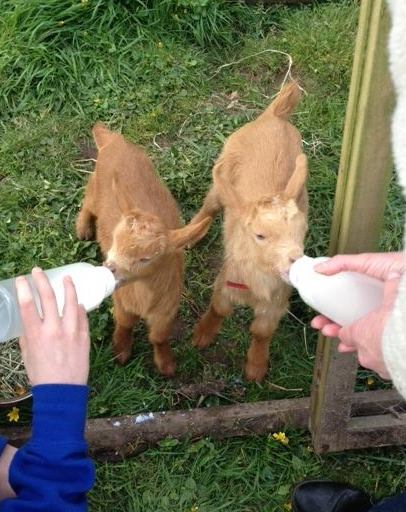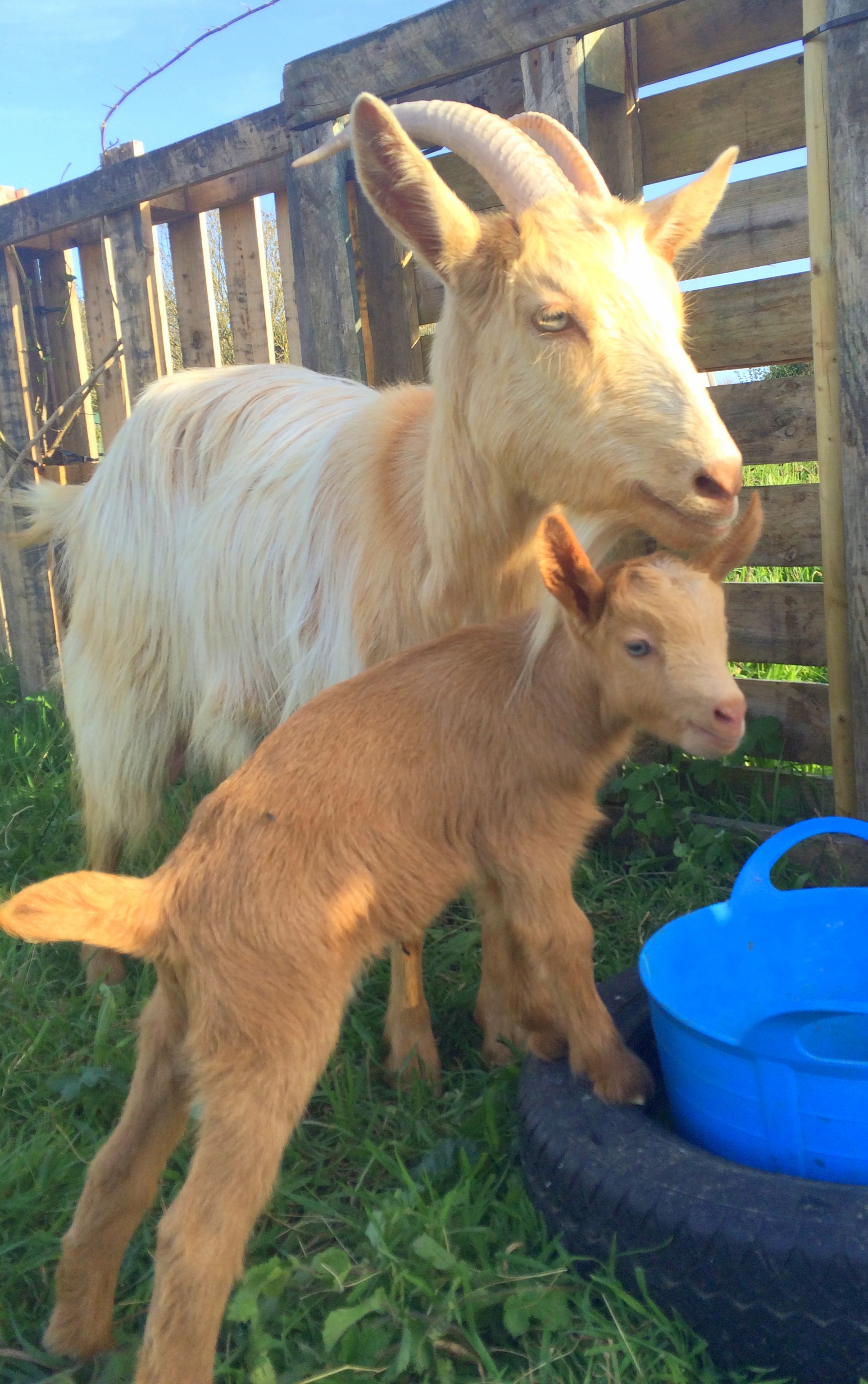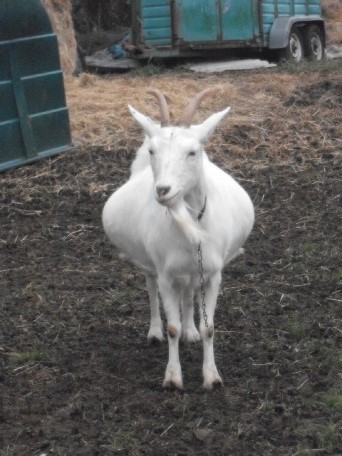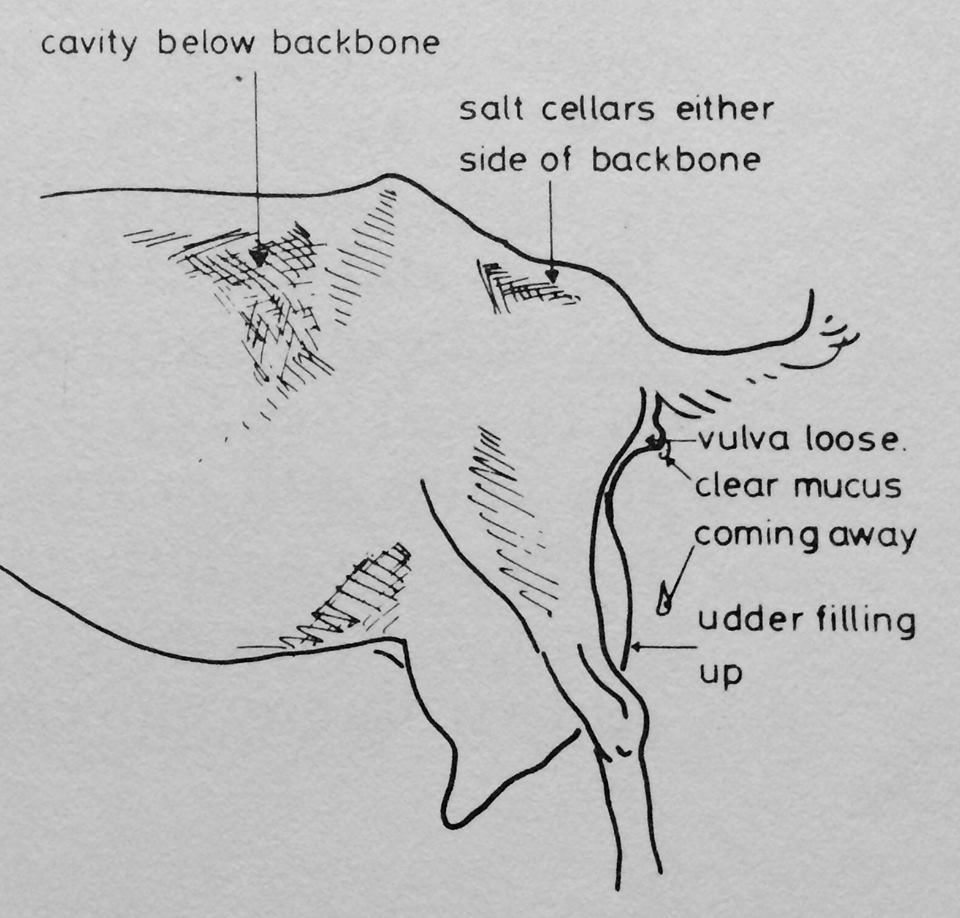By Mandy Girard
All goat kids need a good start in life to maintain health and grow well.

The first four days of their life the kids will have been feeding small amounts of colostrum from the Dam. The milk then starts to come in and feeding increases. This is quite often the stage that many people take the kids off of the Dam, so that they can get a better milk yield from the goat, she will only supply the need of her kid/kids but has the potential to give far greater amounts if milked out completely twice a day.
There are several methods to choose from depending what your aims are:
Option One
If you want a good milk supply or you want to show the Dam, it is best to take the kids off of her and bottle feed them, this will prevent the udder from possible damage and keep it looking tip top for the shows, as you will milk out evenly but a kid or kids will not.

Option Two
If showing is not a consideration and you want a small milk supply, it is possible to let the Dam feed the kids and get your milk too! Take off the same amount of milk each day at the same time and she will feed you and the kids. (First thing every morning before the kids have suckled) Do not keep changing what you do, it will confuse and annoy the goat and the kids!
Option Three
Leave the goat to it and do not milk her at all. She will wean them herself when she sees fit.
You must make sure the Dam is fed well which ever method you use, as her body will suffer by giving all the nutrients to her kids. Feeding well does not just mean large rations, it means good forage, (hay, green stuff, branches). Increase concentrates slowly to a goat that has just kidded.

Bottle feeding
This is either done using fresh goats milk or a powdered milk replacer.
Either way the milk needs to be at the correct temperature and from clean bottles, sterilize them after each feed, the quickest way to get sick kids is by not bothering with these two things.
It is very important to make sure the milk is mixed correctly as per instructions on the bag of milk replacer. Mix required amount of water to powder by making it into a paste and then gradually adding the rest of the warm water. The temperature should be no higher than 40c (by the time you have mixed it, filled bottles and got out side to the kids it will have dropped to 39c, which is perfect) Make sure the hole in the teat is large enough, the kids will get frustrated if it is too small. Each kid will have a different appetite. Do not be surprised if they want more one feed or less the next, they stop sucking when they are full!
When to drop each feed and wean your kids depends what you aim to do with them when they get older. Goats which are required for breeding/milking need more calcium to become good milkers. Left to wean themselves most goats push their kids away within the first six months, so this would seem to be the obvious time frame for weaning. I have had much younger kids refuse the bottle though and prefer to go onto hard food. They never suffered for it and turned out to be good milking stock. Many goat breeders maintain that feeding a Billy right through its first winter is good practice.
As each bottle feed is dropped the hard feed needs to be increased accordingly. Eventually you will be replacing the bottle feeds with the twice a day goat mix feed, which also gives you the opportunity to check your goats twice a day.
Hard Feed
Goat mix can be offered once a day, only a handful between two kids is needed to begin with. Hay and water should be available at all times throughout the year for all goats of all ages. (Hay is vital particularly in the winter when there is no goodness in the grass) It is always good practice to let kids fill up on hay before letting them out onto fresh grass each day. Letting them onto wet grass first thing in the morning is bound to cause tummy upsets. (Messy)!!
By the time the goat reaches the winter the amount of hard goat mix can be increased to two feeds per day. How much goat mix to give per day depends upon the breed and size of the goat, in my experience too much can cause problems. It is far more important to bulk up the goat with good hay and forage.
Scouring
This is when the goat gets diarrhoea. Many things can cause this:
Incorrect mix or temp` of milk/ stress/ over eating/chilling/parasites/worms.
The temptation to over feed young animals should be avoided, it only makes them ill and lots of unpleasant work for you cleaning them up! Never leave a whole bucket of goat mix for any age goat to help itself to, thinking you are saving yourself time; you will probably find either a very sick or dead goat when you return.
Medication/feet trimming and care of your kids
Clippers for foot trimming are available online from Goat Nutrition Ltd, Mole Valley Farmers or Amazon.
From 8 weeks you can start foot trimming. They never seem to enjoy it, but going lame is the alternative! (Being an octopus would help!) Please visit our 'Health & Wellbeing' pages for a description & video on foot trimming….& good Luck!
Medication
3 weeks: Vecoxan by mouth for worming
4 weeks: 1 st vaccination Lambivac
6 weeks: Vecoxan by mouth
8 weeks: 2nd vaccination Lambivac
Start worming your goats from 8 weeks old, consult your Vet for the best wormer to use, since there are none available designed for goats!

Ear tags/ pastern tags
Your goats will have been tagged before you purchased them. (This is done by law and Farm Services ;if you are in Guernsey, will have been given details that you now own goats) Ear tagging is very similar to ear piercing and care needs to be taken that the ears do not get infected. Mostly nothing needs to be done, but we find that turning the tags every day for a week helps to prevent sticking and infection. Please seek advice if there seems to be a problem or the ears look swollen.
An alternative to ear tagging has recently been introduced, which is a tag around the pastern, on the leg of the goat. Either are a means of identifying the goat and must be done by law.
If you have recently had a goat produce kids, you also need to think about registering them and details can be found on this website on the procedure for this.
Housing/shelter
Kids that have just been separated from their Mother need to be looked after carefully as they do not have the sense to go in when it rains or at night straight away! You need to shut them in and get them used to the place that is warm/ safe and dry for bed, it will not take them long to realise that they need to run here when it rains or they feel unsafe. When left outside they will always need the option of shelter their whole lives, they do not like to get wet!
When to consult a VET
A healthy kid is bright eyed, active, has a shiny coat and should produce rabbit pellet droppings. If your kid shows symptoms of lethargy, floppiness, depression, staring coat, constant scouring; consult your Vet or please contact us for advice if you are not sure.

Mating, Pregnancy & Kidding
by Mandy Girard
The first signs of heat/oestrous in your goat usually appear in the autumn or late summer.
They include:
- Tail may be raised and twitching
- Loud calling/bleating for no apparent reason
- A clear discharge from the vagina may be visible
- The goat may go off her food
- If she has already kidded before, the udder may be tender when you are milking her and the yield may drop slightly
- She may follow after other goats in your herd and even try to mount
Having established that she is on heat, this usually lasts for a couple of days, so make a note of the date and three weeks later she should cycle again, this gives you time to arrange with the owner of the Billy you have chosen.
All members of The Goat Society have access to The Herd Book and it is available by request from the Registrar should you wish to look at pedigrees of goats to ascertain which Billy to use. If you are not sure which Billy you should use then it is wise to speak to the Registrar who can look at the pedigree of your goat and help you to come to a decision. Likewise any of the other members on the committee may be willing to give you advice.
Please be considerate and make sure you are taking a healthy and clean goat that has up to date vaccinations. The owner of the Billy will have told you where and when to bring your goat, you should also be aware of the stud fee.
Commonly the fee is paid at the first service and if the goat is in season again three weeks later a second service is allowed. Should your goat come into season again then it is up to you to discuss with the stud owner what to do next. The Stud Billy is usually tried and tested therefore it may be that your goat is not receptive or you are coming at the wrong time, either way you cannot expect the owner to keep sparing his time and not be paid.
Once pregnancy is suspected (the next heat is missed) you can presume your goat is pregnant and is due approximately 150 days from the service date.

The owner of the Billy will have taken down the details of your goat and a service certificate can then be issued by them. The certificate is your proof to hand in with registration application to the registrar once your kids have arrived. You cannot register kids without it and all future off spring from your kids will also not be registered if you have not done this. Stud certificate books are available from the secretary and will also be available at the shows.
Going into labour & kidding
Many of us are now playing the waiting game of looking forward to our new arrivals and some of you are expecting kids for the first time! It never gets boring and always keeps us guessing, from ‘ Is she, isn’t she pregnant’ to ‘Is she, isn’t she in labour’! Help is always available from other experienced goat keepers but your Vet should always be called if in doubt. Most of the time it is all over before you get there, unless you know what to look for, (having said that, you can easily miss it by going for a cuppa.)
The following are some general signs for the onset of labour. Most are taken from the very good book by David McKenzie, Goat Husbandry or from the Golden Guernsey Goat Society leaflets, England. We have also found, The Goat keeper’s Veterinary Book by Peter Dunn, very useful.
Left to themselves a goat that is in labour will go and find a nice quiet/dark area to kid in. If you have only a few goats she probably has her own pen and you need not do anything different. If the pen is not easily accessible and has no form of light nearby, you may wish to move her to a better spot in case you need to help her or get a vet out. He will not appreciate crawling into a dark calf hut in the middle of a field! By now you will know that goats do not like their routine changed so do it at least a week before she is due to kid, that way she will have time to settle and start nesting! Obviously a clean bed is needed. She will only need to go in the pen at night if the weather is good, getting out and exercising as normal is best.
If your goat stops eating in the last two weeks prior to kidding you must act quickly. Pregnancy toxaemia is difficult to treat the longer it is left. Call the VET!
Your goat should have her Booster Vaccination for enterotoxaemia/tetanus (Lambivac) two to four weeks prior to her due date. Trim her hooves. Worm mid pregnancy. Check for external parasite & treat as necessary.
Before kidding
4-6 weeks : A Goatling/or first kidder starts to make an udder.
The vulva may look puffy/pink.
2-4 weeks : Ridging up starts. This is when the backbone from the hips to the tail starts to rise up.

1 week: Ridging up is more obvious.
3 days: Second and subsequent kidders udders will start to fill up quickly.
The goat may drink more.
48hours: Becomes restless, may behave differently.
12hours: Looks uncomfortable/restless, keeps getting up and down.
Stares at the wall /paws bedding. Keeps looking at her tail and may talk to the kids. She seems alien to the rest of the herd and will not usually go out.
Clear or pink vaginal discharge may be seen.
Ridging up - Just before kidding the pin bones/hip bones become more prominent as the muscles surrounding those bones relax & prepare for kidding.

Kidding and after care.
On average the gestation period for the goat is 150 days from service date to birth, 143 – 157 days is quite normal.
Once you are certain your goat is in labour the next thing to do is be patient and don’t over fuss her.
All she needs is a quiet clean pen, a full hay rack and bucket of water. (Put the bucket at a higher level if possible to avoid a kid being dropped in it and drowned; some goats do kid standing up!)
The behaviour of the goat is quite interesting to observe if you have the time. Some goats will just stand in a corner looking absently at the wall or staring into the corner at the roof! They may talk to their belly and kick it, paw the ground, keep getting up and down and smelling the bedding. First kidders sometimes behave as if they were on heat, this is all normal.
On average the labour is around 12 hrs for a second or subsequent kidder. A first kidder may take longer, up to 24 hrs.
The second stage of labour has started when any clear discharge seen before, now appears thick and cloudy white.
The goat will now become very restless not knowing where to put herself, getting up and down and changing position.
First kidders may be very noisy as they start to strain and push, it sounds awful but will all be over soon. If you are able to note when straining first started you can reckon that your goat should not have to push hard for longer than 30 minutes.
If nothing is achieved by this time it is possible that the kid is in an awkward position. If you have no experience and no one with experience to help, you must call the Vet.
Most commonly the water bag will appear not long after the goat has started pushing, this will burst the bag and you will see a foreleg, then a second one and the kids nose just visible on top of the two.
The next few pushes will deliver the kid. Clear any mucus from the nasal passages and slide the kid round to the Mum to lick dry, vital for bonding and no problems with your goat feeding her kid. Do not try to clean the kid and then give it to her, she may reject it and you will have a lot of work on your hands, let nature take care of itself. Further kids may be born and much quicker exits than the first one. All the after births will follow and if you do not see any and the goat obviously still retains it. You need to get advice from your vet if nothing has been delivered after 14hrs, do not try to pull it out!
The diagrams shown here, describe what can be done to reposition the kids if you are patient and the help is not arriving quickly enough.
After care.
Spray the naval of the kids with tetramycin (blue spray) antiseptic. Check that they are all normal, no extra teats etc…
The kids should take some colostrum (first milk) as soon as they are on their feet. Make sure they do and if there is any chance that the goat is not happy with this, you may need to draw some milk off of her to feed in a bottle, just to get things started and get your kids strong. The goat will usually settle down once her udder is relieved a bit.
Wash the goat’s back end and leave her to rest and settle with her kids. Put some fresh hay in her rack and give her a bucket of warm water with molasses (black treacle) in it. Do not over do the concentrates for the first week, but offer plenty of green stuff and then gradually work in the concentrates again. I like to put a ridged box, on its side in the pen in one corner, with hay/straw in it, for the kids to have a dark, warm area to sleep. This gives your goat some peace and also enables the kids to keep their body heat better, make sure it is accessible, so that they can get to their mum to feed easily.
Male goats not intended for breeding need to be neutered, please see advice from the State's Vet below.
"The Animal Welfare (Guernsey) Ordinance, 2012 makes castration of livestock by livestock keepers or owners illegal unless licensed by this Department. This includes the use of elastrator rings and any other techniques.
Any livestock keeper who wants a licence to castrate lambs, kids or calves will need to demonstrate competence in the technique to an officer of the Department in order to obtain a licence. A licence will only permit the castration of an animal within the first 7 days of age of its life. Alternatively castration can be carried out by a registered veterinary surgeon using an anaesthetic."
If you are having your kids polled/disbudded this has to be done in the first week and your vet can do both procedures at once.
|
GUIDE TO THE REGISTRATION OF KIDS Obtain holding number from Farm Services – Telephone: 234567 Order Tags and applicator from supplier of choice (see Note 1 below) Once tag is applied to kid registration may be applied for. If new to breeding, an Affix must be applied for from the TGGS. Please complete the relevant application form. Complete an “application for registration” form. On receipt of the completed application form/fee and service certificate (obtained from the owner of the stud male used) registration will be processed and a registration certificate returned to the breeder. If a registration is urgent please state on the form. Please note that it is acceptable for the purpose of show entries (kids only) to put “RAF” (registration applied for) should there be a delay in the processing of your registration. Please note that any non-self markings such as white or black must be disclosed on the registration application form (see note 2 below). Transfer of ownership when goats are sold is the responsibility of the Vendor not the Purchaser. In the case of kids the registration and transfer may be done at the same time (please remember to submit a transfer request form). For transfer of ownership of adults and registered young stock, the Certificate should be returned together with a transfer application form duly signed. All Royal Golden Guernsey Goats conforming to the Breed Standard will be registered in the “Golden Guernsey Herd Book”. The Breed standards for Royal Golden Guernsey Goats are as follows: Only pure Golden Guernsey Goats can be classed as "Royal" and must be registered either in the local Golden Guernsey Herd Book or with the British Goat Society (BGS). These goats should comply with the Breed Standard: HEAD: Ears erect with a slight upturn at the tips. Facial line dished or straight. No tassels. BODY: Smaller than the other breeds. Fine boned. SKIN: A shade of gold, neither pink nor grey. COAT: All shades of gold with or without small white markings and blaze or star on head. No Swiss markings. Hair long or short. MALE COAT: Usually carries more hair than the female. In the Island of Guernsey we now ask for a photo of the kid to be sent to the registrar with the application form or arrange for it to be seen. Note 1. The Tag numbering system works as follows: Herd number – 15 represents Guernsey, 8 is the number identifying goat as the species followed by your 3 digit holding number, for example 158999 This number will appear on one side of the tag and a unique identification number on the other side. Note 2. White markings, depending on size and position, may result in a kid being registered in the “Identification Register” (see Breed Standard). There is no method by which a goat may be upgraded from this register and any resulting offspring will also be “Identification Register” stock. Such goats are not eligible for entry in the Golden Guernsey Goat Breed Society Show and must be entered in any show as “any variety”. Any kid with Black or Swiss markings must be registered in the “Identification Register”. Any neutered kids must be registered in the “Identification Register”. The Registrar should be notified in the event that a kid is neutered after registration in the “Golden Guernsey Herd Book” in order that a note may be made in the Herd Book regarding breeding status. Please also notify the Registrar in the event of the death of any registered goat. Non Golden Guernsey Goats may be registered in the “Identification Register”. However, if such goats are pure bred it may be beneficial to register such animals with the British Goat Society in order to maintain “Herd Book” status. All goats born October 2013 onwards by law have to be tagged. Also any stock (any age) sold from your premises that was previously not tagged , must now have a tag. Please contact Caroline Creed at Farm Services to notify them of new stock. Tel: 234567 or email: farmservices@commerce.gov.gg
For further information on breeding please see The British Goat Society's advice |
